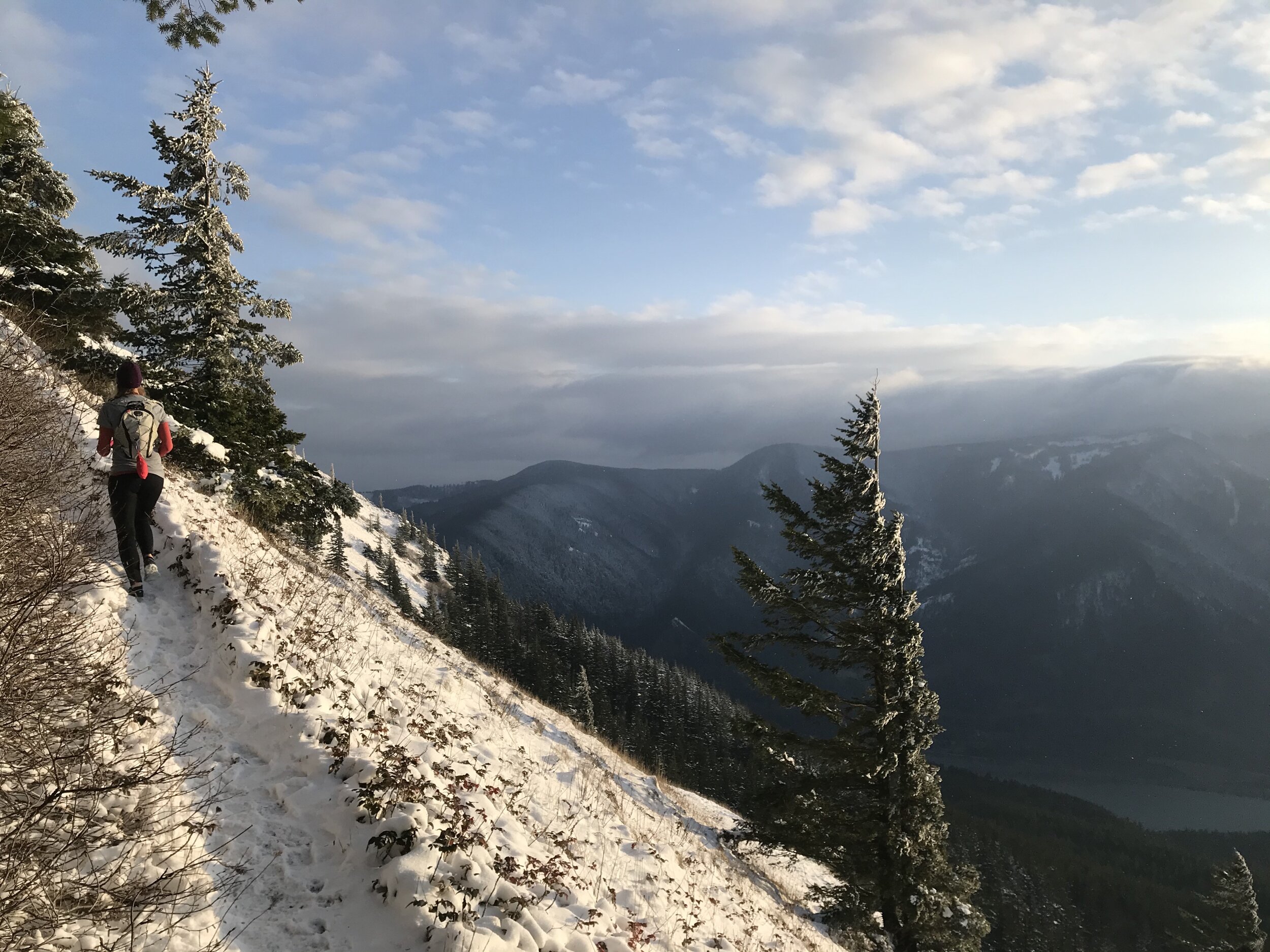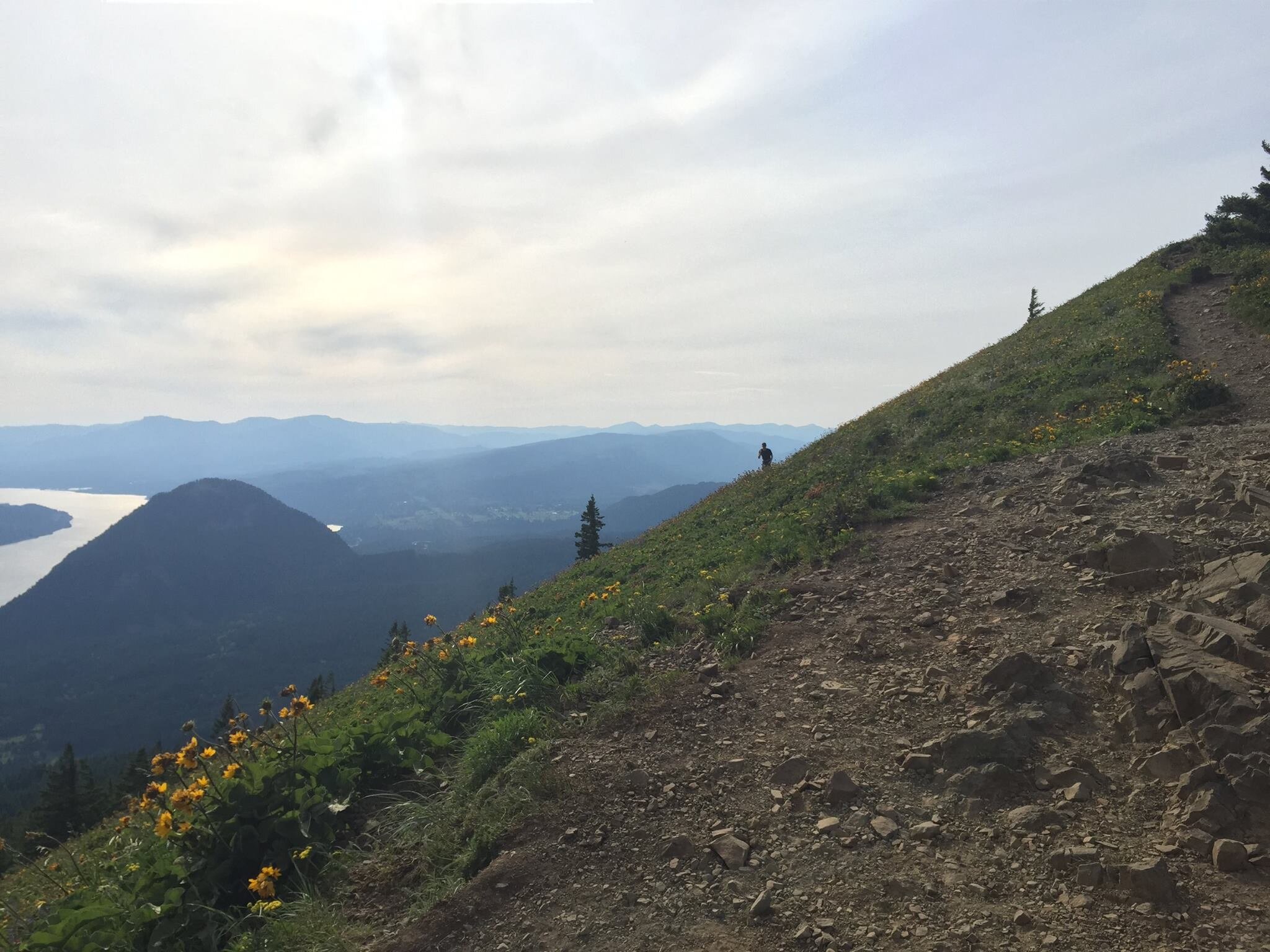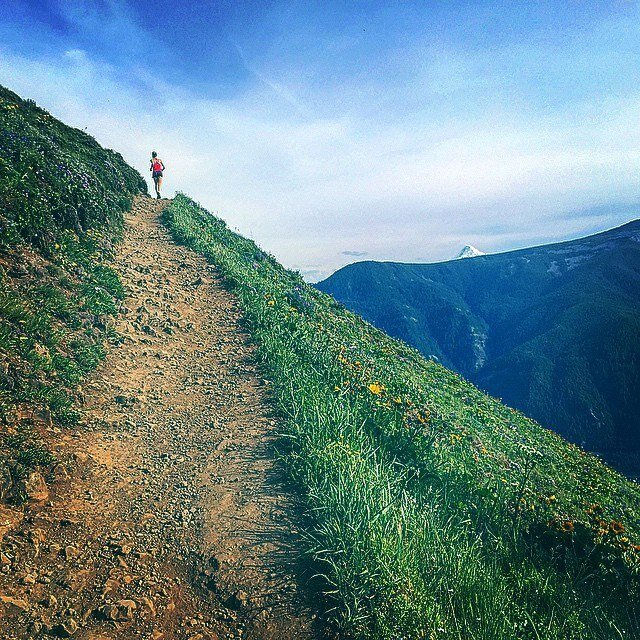Stay hydrated to handle the heat
Heat is sneaky.
And it’s been a hot one this year in the Pacific Northwest with record-breaking ridiculously high temperatures (we reached 117 in Camas) in June and we’re getting another above 100 heatwave this week.
But even so, with our cool mornings and low humidity it can be easy to forget how the heat affects us and what we need to do to be prepared when exercising in it.
In early June, as the temperatures were just starting to warm, Jonathan and I headed to the legendary Dog Mountain Trail in the Columbia River Gorge. It was a great day. We left on a Friday afternoon and temperatures were in the low 70s.
We were at the end of peak season for wildflowers and had never seen them in full bloom before on Dog Mountain. They are spectacular and yellow, my favorite color.
We were determined and we’ve run up Dog Mountain several times in various elements, including ice and snow. I felt confident.
But mother nature had a different plan and I wasn’t tuned in. The wind was high, possibly the highest we’ve had when going up Dog Mountain. It’s typically windy in the gorge, and especially at the top but it was hard to keep the jeep doors from slamming in the parking lot.
It didn’t cross my mind at the time, but in addition to heat, humidity, sun, rain, ice and snow, wind is always a factor we need to consider. And in terms of heat, it makes it hard to sweat. The wind cools and dries you, which feels good, but it can also deceive you, making it hard to know how overheated you might be getting.
I take hydration seriously and I work on it with clients daily. But I am human and I probably didn’t pre-hydrate enough before our somewhat impromptu trip to Dog Mountain. How much you drink during and after exercise is important, but even more important is how much water you’re taking in the hours and even days leading up to a big event.
That big event could be an activity or it could be an excessive heat wave. Either way, the rules of hydration need to be followed. Break those rules and your body has to work much harder at everything from walking to digesting your food.
Excited and eager to see the flowers we started running up the incredibly steep mountain, one of the more challenging climbs in the gorge with a nice 2,800 elevation gain in about 3 miles to the top. We took a bit of a longer route down, making our entire trip around 7-8 miles.
I took my time, settling into a slow jog pace. I felt fine other than lungs exploding and calves burning, not uncommon for hiking or slow jogging up Dog Mountain. We had water and I was drinking, but the sun was blazing.
Jonathan joked to a hiker as we ascended, “getting closer to the sun!”
And we were.
It was dusty, arid and warm but I didn’t feel hot so I assumed my fatigue and struggle was from the exertion of the climb.
Nature would teach me a lesson (not her first and certainly not her last).
About two-thirds of the way up we stopped to take in the view and Jonathan says:
"Are you ok? Do you want to turn around?'"
Me: "Why? How far is it?"
He pointed up to what looked like a switchback to the clouds a million miles away. ‘Weird, I thought we were closer to the top,’ I said in my head.
But I told Jonthan I wanted to keep going, I wanted to get to the top.
A little while later and much closer to the top Jonathan stops again (I was quite a ways behind, feeling the need to hike in between short spurts of very slow jogging).
"Are you ok?"
"Yes," I said, but thinking ‘This is a bit strange. Typically, Jonathan's pushing me along telling me to keep it going, to embrace the suck and generally motivating me to keep my mind from giving up.
‘Am I OK?’ I wondered.
I checked in.
I felt nauseous, a certain sign of dehydration. I drank some water. We paused. I ate some raisins.
“Do you want to turn around?” Jonathan asked, clearly concerned.
We were so close to the top, I knew it. We’d been there before. I really didn’t want to give up now. I knew I’d feel a lot better once we started descending and so I took some breaths in and out through my nose, calming the panic and fear that had only set in when asked if I was OK. That simple thought of not being OK has sent me into a tailspin in the past, letting anxiety take over and causing me to breathe through my mouth, get more dehydrated, dizzy and put myself at great risk for a bad day.
But I knew I could stay calm, drink my water, breathe in and out through my nose and make it.
“No, let’s go. I’m ok. I want to get to the top.”
“And loop around?”
Our plan was to take the Augspurger Trail down, which includes a very exposed and narrow connector trail. I’ve been working for years on my fear of exposure and my general anxiety. And for us to be safe I need to trust myself that I won’t panic. And Jonathan needs to trust that too.
“Yes,” I said, “let’s do it.”
“Let’s just hike,” Jonathan suggested.
Smart thinking. I was getting overheated and needed to avoid heat exhaustion or worse.
I’ve had heat exhaustion once before, during a marathon, which forced me to walk and go to the medical tent after I finished. I was fine then too/ just needed rest and fluids. Heat exhaustion can lead to heat stroke if not resolved, and that can be deadly.
The best thing to do is slow down, rest, get cool and drink water. All things we were able to do and did do. It’s also important to know the signs, not just for yourself but especially for those you are adventuring with. Jonathan, a personal trainer and avid outdoorsman knows the signs well and knows my behavior to see signs that something’s not right. If you think a friend or someone you are hiking/running or doing anything outside with is showing signs of heat exhaustion, stop, get them cool and get medical assistance right away if needed.
I steadied myself, drank some more water and told myself: ‘Breathe through your nose, in and out. This is the best way to preserve your hydration and lose less water. Mouth breathing is very dehydrating.
Nasal breathing is also the best way to stay calm. ‘In and out through your nose’ was my mantra to the top and I could do that while hiking. Slow and calm, just breathe.
I took some breaks when it got even steeper and we paused at a magnificent viewpoint at the top. No wildflowers photos for us as safety and making sure we were good to get back down was the top priority.
The trali gets very exposed and very windy at this point. It’s intense but the beauty is magnificent and I felt a surge of energy and excitement to see yellow, red and purple wildflowers blanketing the side of the mountain.
The nasal breathing worked.
It wasn’t an easy descent- slow- but we did it, mostly running.
As we cooled down at the jeep and got more water I took my hat off and brushed my face to watch salt fall to the ground. I was covered - even my arms- in salt. Clearly not enough electrolyte balance on this run.
Our bodies not only need water - a baseline of half your bodyweight in ounces and more if it’s hot/you’re sweating/exerting yourself- but we also need electrolytes (potassium, chloride, magnesium, sodium).
Salt is especially important, especially if you notice it’s all over your arms and face. Adding a little sea salt and lemon juice to my water and proper pre-hydration would have avoided any trouble for me.
On our next hot run, which was actually in the 90s but on flat terrain, I added a pinch of salt and lemon juice to my water and I felt great. We’ve also been slowly acclimating to the heat, getting outside into the hottest part of the day to lay in the park and get used to it.
The moral: enjoy all the elements, but do so safely.
Hydrate (including electrolyte balance)
Check on your friends. Sometimes our feelings lie or for many reasons we may not realize how we’re doing when fully exerting ourselves. Know the signs of dehydration and heat exhaustion and check in with each other regularly. Don’t be afraid to slow it down or turn back when you need to. There’s no mountain top or wildflowers worth the risk of a hospital visit, or worse.
Need help with your hydration? Let’s chat.
Resources:
Know the Warning signs of heat sickness
Hydration Basics, American Council on Exercise




